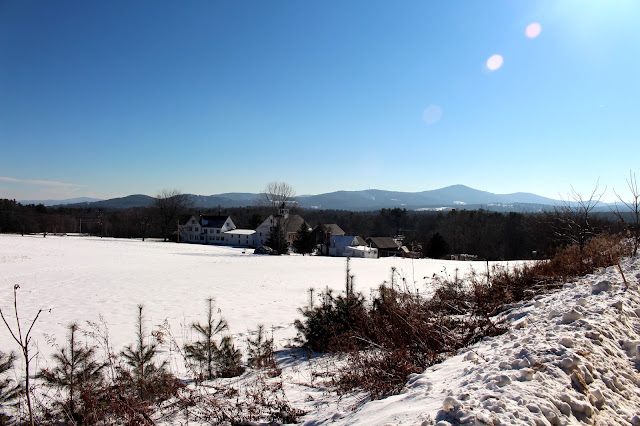Scientists don't know if the warm weather is causing some loons to stick around, but at any rate, five animals have been rescued by the Loon Preservation Committee on Lake Sunapee, four of which have already been released on the ocean (the fifth is being treated for lead poisoning). You can read the LPC press release about the rescue by clicking here. If you become aware of any loons still on New Hampshire lakes during this warm year, contact the Loon Preservation Committee immediately. In addition to delaying the animal's schedules, the warm winter has also delayed the Meredith Fishing Derby by two weeks, and the Pond Hockey Classic has been relocated to Lake Waukewan.
On one of those warm winter days this week we took a trip over to Prescott Farm, a beautiful environmental education center managed in partnership with the NH Audobon Society, and located in the center of the Lakes Region just a mile from Weirs Beach.
 |
| Prescott Farm on White Oak Road near Weir's Beach |
It is a wonderful example of early New Hampshire farms, originally encompassing 700 acres, set high on a hill with views of the Belknap Mountains.
 |
| The Belknap mountains frame the farm to the south |
 |
| Something was recently injured here |
Looking further we saw a porcupine trail and more spots of blood along the trail up to the ledge where it undoubtedly has a den, and down the trail in the other direction as well. We followed the trail back to see what we could learn. It wasn't far - porcupines don't cover a lot of territory - before we found the origin of the event.
The porcupine had been dining on the tender bark of these small beech trees.
 |
| These trees will likely die, the reason orchard farmers don't appreciate porcupine |
When somehow it became injured up on a tree.
Now it wasn't clear just how this guy got injured. Did it cut itself chewing on something sharp? Did it fall on a pointed branch? (Supposedly it's not uncommon for a porcupine to fall out of a tree.) At any rate, it appears it cut itself up on this beech tree and decided to head back to its den to recover. At least a porcupine doesn't have to worry too much about a predator following a blood trail - about the only animal willing to take on a porcupine is a fisher, and even that would have to be pretty hungry.
Farther along the hike we came upon the sugar house and some of the tubing ready to collect this winter's harvest.
 |
| Sugar Shack at Prescott Farm |
 |
| Plastic tubing set out to let gravity direct the sap to a central collector |
The farm holds educational events in sugaring season. I wonder what kind of product this year's warm winter and thin snow pack will deliver....
Back at Lake Wicwas we continue to have lots of rodent visitors (the porcupine is a rodent as well, one of the largest). The squirrels are having fun with their corn cob feeder.
And we've had a little vole scurring around taking advantage of the dropped seeds and corn kernels.
It took a little research to determine what this is, but the short tail, small ears, rounded snout, and daytime excursions distinguish it as a vole rather than a mouse.
It has a multitude of paths running around under the snow, so it pops up suddenly out of the snow in random places with no warning.
It then dashes under a feeder, grabs a morsel, then dives back under cover.
 |
| Supervole! Rescuing that sunflower seed! |
I'll bet the owls had good hunting this week with the bright full moon - I hope you saw it!
 |
| The Full Wolf Moon sets over a stand of white pine |













































